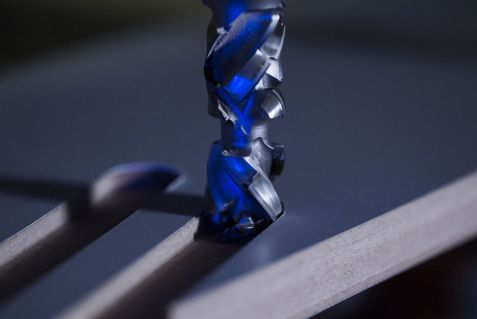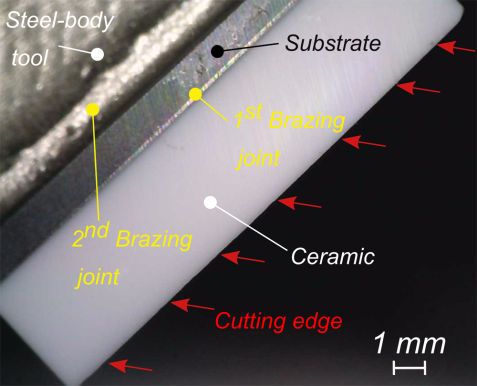MLZ is a cooperation between:
 > Technische Universität München
> Technische Universität München > Helmholtz-Zentrum Hereon
> Helmholtz-Zentrum Hereon
 > Forschungszentrum Jülich
> Forschungszentrum Jülich
MLZ is a member of:
 > LENS
> LENS > ERF-AISBL
> ERF-AISBL
MLZ on social media:

MLZ (eng)
Lichtenbergstr.1
85748 Garching
16.04.2020
Better milling with neutrons
A professional mill for industrial applications is more complicated than most people think. Cutting elements of polycrystalline diamond or tungsten carbide are brazed onto a steel body. A manufacturer of such tools had them analysed with neutrons.
While searching for optimization in cutting tools, the French company DIAMONDE came up with the idea of using ceramic cutting elements. They are harder than the traditionally used cutting material and do not need tungsten or cobalt in their composition. Since ceramic cannot be brazed directly onto steel, employees have developed a new method and applied for a patent: In a two-step process, they first braze the cutting elements in a vacuum environment onto a joining material. They are then able to braze them to the main body of the tool.
Cracks in the ceramic elements
Although this method is promising, the DIAMONDE engineers encountered a problem: After production, the ceramic elements showed cracks that could have formed while cooling down after the first brazing process. This is because the ceramic and intermediate layers expand to different degrees when exposed to heat, and this leads to residual stresses in the material. The engineers wanted to understand these and their effects more precisely and find out whether they were responsible for the cracks in the cutting elements. They approached the Heinz Maier-Leibnitz Zentrum via the European SINE2020 program and were granted beam time at the STRESS-SPEC instrument, which, among other things, specializes in precisely such questions.
Neutrons show the stresses without damage
“We were looking for a method to determine the residual stresses even in deep layers without damaging the ceramic. Neutron diffraction proved to be the perfect answer to this question,” says Flavien Contarato, one of DIAMONDE’s engineers. X-ray diffraction measurements and mathematical models, which the team also carried out, support the result: The first soldering process is not responsible for the cracks since the stresses, at about 12% of the maximum bending force, are too low to cause any damage.
With this good news, the team can now take a closer look at the second soldering process or further optimize the cutting elements. “If we are faced with a similar problem, we will gladly come back to the neutron source”, says Flavien Contarato.
Original publication:
Contarato F, Bach M, Krier J, Gobled A, Mille P. Evaluation of residual stresses during brazing of Al2O3‐ZrO2 to cemented tungsten carbide. Int J Appl Ceram Technol. 2019;00:1–8. DOI: 10.1111/ijac.13413
MLZ is a cooperation between:
 > Technische Universität München
> Technische Universität München > Helmholtz-Zentrum Hereon
> Helmholtz-Zentrum Hereon
 > Forschungszentrum Jülich
> Forschungszentrum Jülich
MLZ is a member of:
 > LENS
> LENS > ERF-AISBL
> ERF-AISBL
MLZ on social media:




